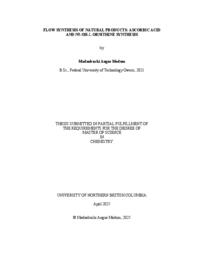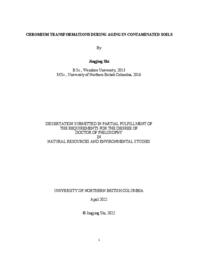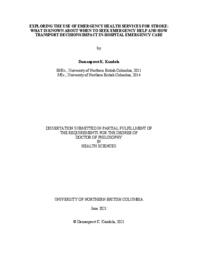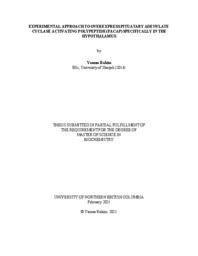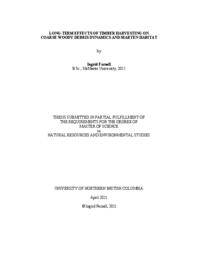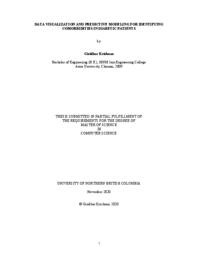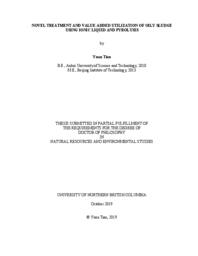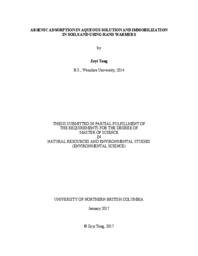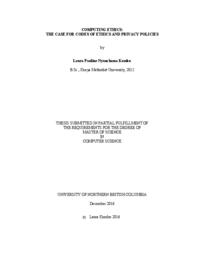Whitcombe, Todd
Person Preferred Name
Todd Whitcombe
Related Works
Content type
Digital Document
Origin Information
Content type
Digital Document
Description / Synopsis
Extensive industrial activities have led to Cr contamination in the environment, which poses threats to ecosystems and human health. Currently, very little is known regarding the Cr accumulation in soils during aging. The purpose of this dissertation was (i) to enhance our understanding of Cr transformations occurring over a long period of time; (ii) to investigate the reduction of toxic Cr(VI) to non-toxic Cr(III) by soil microorganisms for developing bioremediation strategies for Cr-contaminated sites. Soil samples were collected from a longterm (> 30 years) tannery waste contaminated area in Shuitou (China) for this research. Chemical extraction methods showed the Cr(III) form was dominant (> 96.7% of total Cr) in these aged Cr-contaminated soils, with toxic Cr(VI) up to 144 mg kg-1. Of the total Cr(VI) present, immobile Cr(VI) represented > 90%. Synchrotron-based X-ray near edge structure spectroscopy demonstrated Cr species present were CrFeO3, CrOOH, and CaCrO4. The occurrence of immobile Cr(VI) species in long-term contaminated soils was further verified by a spiking experiment over 240-day aerobic incubation. Available Cr(VI) in soils continually decreased during aging, with immobile Cr(VI) increasing by 4.5 – 31% and immobile Cr(III) increasing by 68 – 95% of total spiked Cr(VI). These findings reveal that Cr(VI) reduction and immobilization were occurring concurrently in soils. Cr(VI) reduction occurs in soils with low pH and high organic carbon content via both chemical and biological processes, while Cr(VI) immobilization occurs in soils with cations (such as Ca2+) and Fe oxides. Shotgun metagenomic sequencing was used to analyze the microbial community composition in the soils and a batch solution experiment was employed to determine the Cr(VI) reduction capacity by soil microbial consortia. The results demonstrated the accumulation of high levels of Cr in a soil (e.g., 3141 mg kg-1 in S3-2) led to the increased abundance of Cr resistant and reducing microorganisms: Proteobacteria (69.9%) at phylum level, Betaproteobacteria (39.1%) at class level, and Massilia (12.6%) and Bacilli (0.57%) at genus level. Batch experiment results showed the addition of 1.0 g Cr-contaminated soils reduced 10 – 20 mg L-1 Cr(VI) in 20 mL of K2Cr2O7 solution at the condition of 30 oC at pH 7.8 – 8.0 within 7 days anaerobically and aerobically, when supplied with 0.2 g L-1 of Na-acetate as carbon and electron sources. The amount of Cr(VI) removed was highest (29.0 mg L-1) at 40 mg Cr(VI) L-1 in the presence of soil S3-2. Therefore, prospective application of mixed microbial consortia from high Cr-contaminated soils for bioremediation of Cr(VI)-polluted environments could be expected.
Origin Information
Content type
Digital Document
Description / Synopsis
Kokanee, the non-anadromous life history form of Oncorhynchus nerka, use lacustrine habitat in watersheds draining into the north Pacific Ocean. Kokanee have also been widely introduced into reservoirs following impoundment of rivers due to the construction of dams. Locally-adapted subpopulations of Kokanee, however, should be identified and evaluated when implementing watershed-level management strategies. In Chapter 1, I examined fork length, condition factor, and age at maturity for Kokanee in the Williston watershed of northern British Columbia to identify potential spatial and temporal trends in demographic structure following a large-scale stocking program that occurred in the 1990s. Adult spawning Kokanee that were native to the reservoir and collected prior to stocking events were significantly larger and maintained higher condition factors than Kokanee stocked from the Columbia River sampled in any year after 1991. Introduced Kokanee sampled in 2018 and 2019 were the smallest spawners and were significantly smaller than all fish collected between 1989 and 2018; the condition factors of these fish were also significantly lower than native Kokanee and the first spawning cohorts of Columbia-origin fish. The average age at maturity did not change across spatial or temporal scales (3 yrs.). My results indicate an ongoing trend of decreasing spawner size and condition factor for Kokanee in the Williston Reservoir since introduction events in the early 1990s. In Chapter 2, I analyzed the genetic population structure of Kokanee in the Williston watershed, including from the reservoir before stocking Columbia-origin fish and native populations from headwaters of the Williston Reservoir: Thutade, Arctic, and Tacheeda Lakes. Using microsatellite markers, I identified that all fish collected from 2006 to 2019 were introduced Columbia-origin genotypes, and there was no evidence of genetic divergence by spawning location. Native populations in Arctic and Tacheeda Lakes remained entirely separate from the reservoir populations, and there was no indication of past or current introgression with introduced stock. I identified that native Williston Reservoir Kokanee diverged from the Thutade Lake population; as native Williston fish have not been sampled since 2000, it is likely that this population has been extirpated in the reservoir by the successful Columbia-origin lineage. My results highlight an unfortunate consequence of underinformed management practices that failed to recognize the native Williston Kokanee as a distinct population. Strategies that incorporate knowledge of subpopulations of Williston watershed Kokanee, such as genetic populations or reproductive ecotypes, should be prioritized to conserve locally-adapted genetic diversity.
Origin Information
Content type
Digital Document
Description / Synopsis
Transport practices for seeking emergency stroke care remain largely underresearched and poorly understood, particularly for individuals living in small urban, rural, and remote regions. This multi-method study aims to address this knowledge gap and explores the impact of mode of transport on in-hospital stroke care and the decision-making process of seeking emergency medical attention for patients and their caregivers. Data from the Discharge Abstract Database provide information on stroke-related use of emergency health services across British Columbia. Data from the Canadian Institutes for Health Information Special Project 340 provide information on if calling emergency health services impacts the delivery of care, including the completion of neuroimaging, the administration of acute thrombolysis, and the prescription of antithrombotics upon discharge across a northern health region. Focused, semi-structured interviews provide contextual insight into the decision-making processes for seeking emergency stroke care among patient and caregiver participants in a northern health region. Stroke-related emergency health service use across British Columbia from January 2015 to March 2018 was 67.9% (N=19,849), ranging from 58.8% in Northern Health to 70.2% in Fraser Health. In Northern Health (N=784), there were differences between health service delivery areas for stroke-related emergency health service use ranging from 53.7% in the Northwest to 64.8% in the Northern Interior from January 2015 to March 2018. Similar differences in thrombolytic therapy administration and the prescription of antithrombotics were noted. The odds of emergency health service use were greater for those 65 years of age and older than those younger than 65 and lower for those in the Northwest health service delivery area than those in the Northern Interior health service delivery area. Differences were found for the completion of neuroimaging between males and females. Interviews for patient (n=12) and caregiver (n=7) participants provide complementary contextual insights and yielded three key themes, including the decision-making process following a stroke, experiences of care, and perceived gaps and areas in need of further support. This integrated knowledge translation-informed and practice-driven research addresses health services and policy priorities. Findings are anticipated to help inform the development and refinement of emergency health services in British Columbia by highlighting differences in emergency health services use across geographies and identifying factors that inform patient decisionmaking when seeking emergency medical attention.
Origin Information
Content type
Digital Document
Description / Synopsis
Obesity is adetrimental health condition that occurs when energy intake, exceeds energy expenditure. Pituitary adenylatecyclase-activating polypeptide (PACAP) regulates energy expenditure, including adaptive thermogenesis, through the hypothalamic-sympatheticnervous system-brown adipose tissue axis. We hypothesize that PACAP expression in the ventromedial nucleus (VMN) is required for adaptive thermogenesis. To assess this, our goal is to develop an animal model that expresses PACAP specifically in the VMN of the hypothalamus. As a first step to achieving this goal, we established a protocol to deliver an adeno-associatedvirus (AAV) expressing the visible protein eGFP under the control of a VMN-specific promoter, steroidogenic factor 1 (SF1) using stereotaxic surgery. A second step was to develop a protocol to detect PACAP mRNA in the brain using in situ hybridization. Our results showed that the stereotaxic protocol was successful and provides significant progress towards achieving PACAP-specific expression in the VMN.
Origin Information
Content type
Digital Document
Description / Synopsis
At a long-term experimental trial in northern British Columbia, Canada, I analysed the impact of varying amounts of timber retention: 0% (clearcut), 40%, 70%, 100% (unharvested) on CWD volume, decay class, and inputs from windthrow over 27 years. I used attributes (diameter, length, decay class, and height above the ground) known to be favourable to marten to create an index for assessing the impact of harvesting intensity on CWD habitat features. I then used airborne laser scanning (ALS) to predict CWD volume, habitat value, and piece attributes over the landscape. Stands with 70% retention had CWD attributes that resulted in CWD habitat features similar to unharvested stands. Clearcuts contained pieces that were smaller, more decayed, and closer to the ground, which contributed less valuable habitat, compared to stands with higher retention. Windthrown trees were the majority of CWD inputs and volume change was positively related to percent retention.
Origin Information
Content type
Digital Document
Description / Synopsis
Diabetes is one of the most common chronic diseases in the world. Diabetic patients are also more susceptible to develop additional comorbidities over time even causing death. This makes it essential to identify the risk of developing comorbidities as early as possible for effective diabetes management and to reduce the burden on healthcare system. Large volumes of clinical data which has been collected over the years has potential to be translated into meaningful information to enable healthcare professionals gain insights into diabetic patient comorbidities. This research has two key contributions. First, an interactive diabetes dashboard is developed in which the data is integrated and shown in the form of visually appealing charts, graphs and tables. The dashboard displays aggregated results with drilldown capabilities to allow navigation at finer granularities of various metrics. Second, predictive models are built to forecast the likelihood of one of the three common comorbidities for diabetic patients – Benign Hypertension, Congestive Heart Failure, and Acute Renal Failure. The models use advanced data mining algorithms such as Logistic Regression, Neural Network, CHAID, Bayesian Network, Random Forest and Ensemble. Results from these models are also incorporated into an interactive assessment tool that has the ability to take user input and predict the likelihood of one of these comorbidities. Northern Health (NH) dataset consisting exclusively of diabetic patients is used for this research.
Origin Information
Content type
Digital Document
Description / Synopsis
The effective treatment of oily sludge has been a challenging problem faced by the petroleum industry worldwide. It is a semi-solid mixture of hydrocarbons, water, metallic ions, and suspended fine solids. The recalcitrant nature of oily sludge makes the treatment a difficult and costly task. The objective of this dissertation research was to develop environmentally friendly and economically competitive techniques for oily sludge treatment. Three different approaches were developed: ionic liquid (IL)-enhanced solvent extraction, co-pyrolysis with wood waste, and value-added utilization of oily sludge as sorbent to remove lead (Pb2+) and cadmium (Cd2+) from solution. Firstly, as compared to conventional solvent extraction, the IL-enhanced solvent extraction not only improved oil recovery efficiency but also greatly reduced solvent and energy consumption as well as shortening the treatment duration even at low IL concentration. Secondly, co-pyrolysis of oily waste and hog fuel was conducted in a fixed bed reactor. Three experimental parameters (pyrolysis temperature, reaction time, and hog fuel addition) were explored to optimize both oil recovery and metal ion immobilization. The latter was tested through sequential extraction techniques with high temperature pyrolysis leading to metal ions fixed within the residues. The addition of hog fuel had a significant synergistic effect on the distribution of metal ions in the various extraction fractions resulting in lower risk index (RI) values. Thirdly, the oily sludge-derived char (OS500) obtained at 500 °C could effectively remove Pb2+ from solution with the maximum sorption capacity of 373.2 mg/g (based on a Langmuir model). Sorption of Pb2+ by the OS500 was mainly attributed to its precipitation with carbonate (CO32‒) originating in OS500. The maximum sorption capacity for Cd2+, using a Langmuir model, was 23.19 mg/g. Complexation and metal ion exchange dominated Cd2+ sorption on OS500. The Pb2+ sorption capacity dramatically decreased as the iii pyrolysis temperature increased from 500 to 900 °C due to the decomposition of minerals which could release CO32‒ at high temperature. The activated OS500 showed a higher sorption capacity (90.06 mg/g) for Cd2+ than OS500 (23.95 mg/g) because conversion of barite (BaSO4) to witherite (BaCO3) after chemical activation favored the precipitation of Cd-carbonate.
Origin Information
Content type
Digital Document
Origin Information
Content type
Digital Document
Origin Information
Content type
Digital Document
Origin Information

